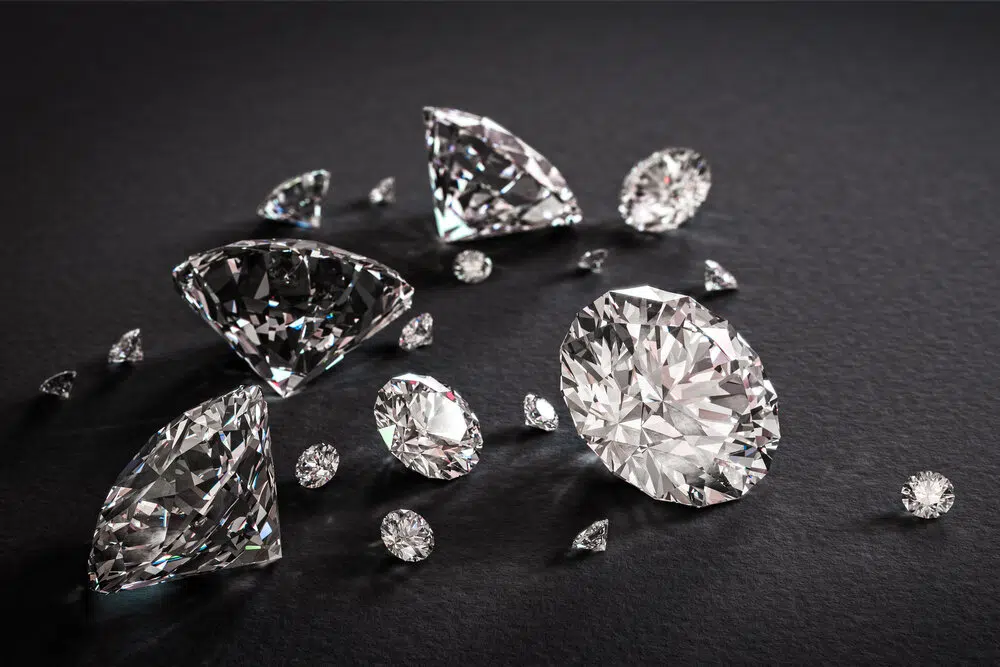
Introduction to Diamonds
What Are Diamonds?
Diamonds — those sparkling gems that make hearts wave and engagement rings sparkle. Regardless, what exactly are they? Chemically speaking, diamonds are a form of carbon, where each carbon atom is stuck to four others in a crystal lattice structure. This intriguing arrangement gives diamonds their extraordinary hardness and brilliance. They’re not just beautiful; they’re unshakable!
The Historical Significance of Diamonds
Diamonds have a long and storied history, from ancient Indian mines to their work in present day pearls. They were once seen as an image of force and heavenly favor. Cleopatra is rumored to have had a penchant for mined or lab grown diamonds, and they were even used in ancient rituals. Fast forward to today, and diamonds are as yet seen as images of affection and extravagance, unmistakably featured in engagement rings and best in class jewels.
Mined Diamonds
What Are Mined Diamonds?
Mined diamonds are the real deal, extracted from the Earth’s external layer through various mining strategies. They’ve been around for an extensive stretch of time, forming significant inside the Earth’s mantle before being brought to the surface through volcanic activity. These natural diamonds accompany their own arrangement of characteristics, making each one exceptional.
The Mining Framework
The journey of a mined diamond starts far underneath the Earth’s surface. There are several strategies to extract diamonds, each with its own arrangement of challenges and environmental impacts.
Sorts of Diamond Mines
Open-Pit Mines: These are essentially large, open openings dove into the ground. They’re useful yet can be visually problematic.
Underground Mines: These incorporate digging tunnels significant into the Earth to reach the diamond stores. They’re less invasive on the surface yet can be hazardous for workers.
Alluvial Mines: Found in riverbeds and ocean floors, these mines extract diamonds that have been worn away from their original stores and washed into new locations.
Environmental and Ethical Worries
Mined diamonds are oftentimes associated with significant environmental and ethical issues. The mining framework can lead to habitat obliteration, water contamination, and substantial energy utilization. Moreover, “battle diamonds” or “blood diamonds” are diamonds mined in war zones and proposed to finance armed battle, raising serious ethical worries.
The Cost of Mined Diamonds
Mined diamonds much of the time accompany a strong retail cost. This is because of the broad mining operations, transportation, and the rarity of natural diamonds. The evaluating can vary generally based on factors like size, quality, and cut, yet desire to pay a premium for these certifiable stones.
Lab-Grown Diamonds
What Are Lab-Grown Diamonds?
Lab-grown diamonds are diamonds created in controlled laboratory conditions that mirror the circumstances under which natural diamonds form. They share the same physical and chemical properties as mined diamonds, yet they are made using current innovation.
The Creation Interaction
Lab-grown diamonds are conveyed using two main techniques:
High-Strain High-Temperature (HPHT) Strategy
The HPHT strategy replicates the high-pressure, high-temperature states of the Earth’s mantle. Carbon is presented to outrageous strain and temperature, creating lab diamonds that are nearly identical to natural ones. This strategy can convey large diamonds rapidly and gainfully.
Chemical Vapor Statement (CVD) Strategy
CVD incorporates placing a diamond seed in a chamber loaded up with carbon-rich gases. The gases are ionized into a plasma, which allows carbon atoms to store onto the seed and form into a diamond. This strategy is significantly controlled and can convey diamonds with less considerations.
The Cost of Lab-Grown Diamonds
Lab-grown diamonds will regularly be more affordable than their mined counterparts. Because they can be created in a controlled climate, the costs associated with extraction and transportation are eliminated. This much of the time brings about a superior expense for quality ratio, making them an attractive decision for economical purchasers.
Quality and Characteristics
Lab-grown diamonds are virtually indistinguishable from natural diamonds to the naked eye. They can be graded using the same criteria (the Four Cs: cut, color, clarity, and carat weight). Additionally, lab-grown diamonds can be made to higher goodness standards and with less considerations, bringing about amazingly clear and brilliant stones.
Comparing Mined and Lab-Grown Diamonds
Appearance and Quality
With regards to appearance, both mined and lab-grown diamonds offer exceptional brilliance. Lab-grown diamonds habitually have less incorporations and can be created with greater accuracy, but mined diamonds have the clever allure of natural origins. The choice regularly reduces to personal inclination and the value you place on a diamond’s history.
Evaluating and Value
Lab-grown diamonds generally offer better value for cash. Since they are created in a controlled climate, their costs are lower, and they can ultimately rely upon 40% cheaper than mined diamonds of the same quality. This value differentiation can be significant while picking larger stones or more intricate settings.
Environmental Impact
Lab-grown diamonds are seen as more environmentally agreeable compared to mined diamonds. The creation of lab-grown diamonds incorporates less disturbances to the Earth’s surface and avoids the complex environmental issues associated with traditional mining. Notwithstanding, it’s worth noting that the energy utilization for creating these diamonds can be substantial, dependent upon the strategy used.
Ethical Considerations
Lab-grown diamonds offer a significant advantage regarding ethical considerations. They eliminate the gamble of “dispute diamonds” and give transparency in their origin. For those worried about the ethical implications of their purchases, lab-grown diamonds offer a more careful alternative.
Picking the Right Diamond for You
Factors to Consider
Picking among mined and lab-grown diamonds incorporates several factors. Consider what aspects are generally important to you: the allure of natural rarity, the ethical advantages of lab-grown diamonds, or the overall cost. Each type has its potential gains and disadvantages, and understanding these can assist you with making an informed decision.
Personal Inclinations
Personal inclination plays a gigantic work in this decision. Certain individuals may favor the traditional value of mined diamonds, while others may be drawn to the innovation and ethical aspects of lab-grown diamonds. Contemplate what resonates with you personally and aligns with your values.
Future Patterns in the Diamond Business
Technological Advancements
The diamond business is creating with advancements in innovation. Innovations in lab-grown diamond creation are making it conceivable to create a lot larger and more flawless diamonds. Additionally, advancements in mining innovation aim to decrease environmental impact and further foster efficiency.
Market Forecasts
The market for lab-grown diamonds should create as more customers become aware of their advantages. As innovation improves and creation costs decrease, lab-grown diamonds could end up being more mainstream. Meanwhile, the market for mined diamonds will continue to be impacted by factors like rarity and historical significance.
Conclusion
Summary of Central issues
Both mined and lab-grown diamonds offer remarkable advantages. Mined diamonds boast natural origins and a storied history, while lab-grown diamonds give ethical and monetary advantages. Understanding the qualifications between the two can assist you with making a choice that best suits your inclinations and values.
Making an Informed Decision
Ultimately, the choice among mined and lab-grown diamonds depends upon what matters most to you — whether it’s the tradition and rarity of natural diamonds or the ethical and cash saving advantages of lab-grown stones. By gauging the potential gains and drawbacks of each, you can make an informed decision that aligns with your personal values and wants.


